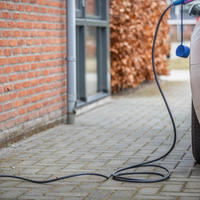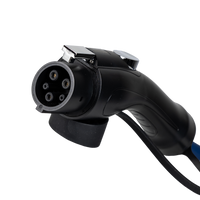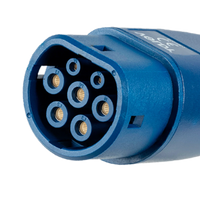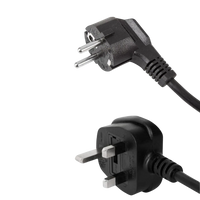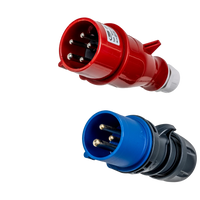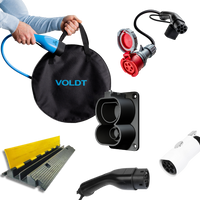
FAQ
-
How fast will my package be delivered?
If you place your order before 15:00 on a working day, it will be shipped the same day. Voldt® offers free same-day shipping as part of our commitment to fast and reliable service. Delivery usually takes between 1 and 3 business days, depending on your location and the courier’s schedule. All orders are dispatched directly from our European warehouse and include full tracking, so you can follow your package from dispatch to delivery with complete peace of mind.
-
How can I receive information about the shipment of my parcel?
Once you have placed your order and made your payment, you will automatically receive an email with information about the tracking number of your parcel.
-
Are Voldt's charging cables suitable for every charging station in the United Kingdom?
Yes, Voldt® EV charging cables are compatible with all standard public and home charging stations in the United Kingdom that support Type 2 connectors. Type 2 (IEC 62196-2) is the official standard for EV charging infrastructure in the UK and across most of Europe, and all Voldt® charging cables are designed to meet this specification. This ensures seamless connectivity whether you’re charging at a public station, a wallbox at home, or a destination charger.
Voldt® offers a wide range of Type 2 charging cables with different amperage and phase options, such as 1-phase 16A, 1-phase 32A, 3-phase 16A, and 3-phase 32A. These variants ensure optimal charging performance depending on your vehicle's onboard charger and the capacity of the charging station. All cables are CE and TÜV certified and manufactured in Europe, ensuring high quality, safety, and full compliance with UK and EU regulations. The cables also feature industry-leading weather resistance, making them reliable for outdoor use in the UK's variable climate.
In addition to standard Type 2 to Type 2 cables, Voldt® also provides mobile charging solutions such as Type 2 to UK 3-pin plug (BS 1363) adapters. These are particularly useful for charging from regular household sockets in the UK. This flexibility ensures that even in locations without a dedicated EV charger, your vehicle can still be charged safely and efficiently. If you're unsure which cable best suits your vehicle or location, Voldt® provides a helpful cable selection tool and expert customer support.
-
Can you extend an EV charging cable?
No, you should never extend an EV charging cable using a regular extension cord or by adding a cable between the charging station and the vehicle. EV charging cables are engineered to handle high electrical loads safely and must comply with strict international standards such as IEC 62196 and IEC 61851. Using an extension cord not designed for EV charging can lead to overheating, voltage drops, or even serious safety hazards like electrical fires. Therefore, extending an EV charging cable is both technically unsound and not legally allowed in many regions.
If your current EV cable is too short, the safest and most technically appropriate solution is to purchase a longer certified EV charging cable. At Voldt®, for instance, we offer cables in various lengths, ranging from 2 metres up to 40 metres. Our cables are CE and TÜV certified, meaning they meet the highest European safety standards. They are also made in Europe and equipped with extremely weather-resistant connectors suitable for outdoor use throughout all seasons.
It’s also important to note that most mobile EV chargers (like the Voldt® Type 2 to Schuko or Type 2 to CEE models) include features such as temperature sensors, overcurrent protection, and smart communication between the vehicle and the cable. If you add an extension cord, these safety systems may no longer function correctly, which could prevent your vehicle from charging or cause malfunctions. If you need more flexibility, the best approach is to choose a mobile charger with a longer fixed cable length tailored to your needs—without any unsafe extensions in between.
-
What is the difference between Mode 1, Mode 2, Mode 3 and Mode 4 charging?
The difference between Mode 1, Mode 2, Mode 3, and Mode 4 charging lies in the level of communication and safety between the electric vehicle (EV), the charging cable, and the power source, as well as the type of current used (AC or DC). Each mode represents a different way of delivering electricity to an EV, with increasing levels of control and safety from Mode 1 to Mode 4.
Mode 1 charging is the most basic and outdated form of EV charging. It involves a simple cable that connects an EV directly to a standard household socket (AC), with no built-in communication or safety features. The cable lacks a control box, so there's no way to verify if the vehicle is drawing power safely. As a result, Mode 1 is rarely used for modern EVs due to high risks such as overheating, electric shock, and potential fire hazards. It is also not compliant with many international safety standards, and is banned in several regions.
Mode 2 charging improves on Mode 1 by adding an In-Cable Control and Protection Device (IC-CPD). This allows the charging cable to plug into a standard socket (usually Schuko or BS 1363) while integrating basic safety functions like temperature monitoring and earth leakage protection. The IC-CPD enables limited communication between the cable and the vehicle, typically restricting the current to safe levels (usually up to 10 A or 13 A). This makes Mode 2 a practical solution for occasional or emergency charging at home, but it’s not ideal for regular use due to slower charging speeds and stress on domestic wiring.
Mode 3 charging involves dedicated EV charging stations connected to the AC grid, using a Type 1 or Type 2 connector and enabling full communication between the EV and the charging infrastructure. These stations can deliver higher current levels (typically up to 32 A or even 63 A), resulting in faster charging. Mode 3 setups include advanced safety protocols such as automatic power cut-off, dynamic load management, and secure identification. This is the standard mode for public AC charging points and home wallboxes across Europe, especially using Type 2 connectors in accordance with IEC 61851.
Mode 4 charging is used exclusively for DC fast charging. In this mode, the AC to DC conversion happens within the external charger, not inside the vehicle, allowing for much higher power delivery—typically from 50 kW up to 350 kW. It requires heavy-duty connectors like CCS (Combined Charging System) or CHAdeMO and involves constant, high-level communication between the vehicle and the charger for current regulation, battery monitoring, and thermal management. Mode 4 is ideal for quick top-ups on motorways or commercial fleets and is governed by standards like IEC 61851-23 and IEC 62196-3.
In summary, Modes 1 and 2 are for basic or household charging (AC), Mode 3 is the most common AC charging method with integrated safety and communication, and Mode 4 is used for rapid DC charging with full system integration and high power delivery.
-
How much electricity does charging an electric car consume?
Charging an electric car typically consumes as much electricity as the size of its battery in kilowatt-hours (kWh), with some additional overhead due to energy loss during charging. For example, fully charging an electric vehicle (EV) with a 60 kWh battery generally requires about 60 kWh of electricity. At an average electricity tariff of €0.22 per kWh, this results in a charging cost of approximately €13.20. However, actual electricity consumption may vary depending on a number of technical and environmental factors.
Here are the key factors that influence electricity usage when charging an EV:
- Battery capacity: Most EVs have batteries ranging from 35 kWh (e.g. Renault Zoe) to over 100 kWh (e.g. Tesla Model S Long Range). The larger the battery, the more electricity is needed to charge it fully.
- Charging efficiency: Energy losses of 5–15% can occur during AC or DC charging due to heat and conversion losses, meaning that you may need to draw more energy from the grid than the battery’s rated capacity.
- State of charge and usage pattern: If you usually charge from 20% to 80%, you will consume less energy per session than a full cycle from 0% to 100%. Preconditioning and battery temperature management can also affect consumption.
For a more accurate estimation, consider the following:
- Multiply your battery capacity (in kWh) by 1.05–1.15 to account for charging losses.
- Check your local electricity rate (per kWh) to calculate charging costs.
- Use smart charging solutions or mobile chargers like those from Voldt® to improve efficiency and track consumption precisely. These offer compatibility with household sockets or industrial power outlets and come with integrated safety features to reduce energy waste.
By understanding your vehicle's battery size and charging habits, you can make informed decisions about electricity usage, costs, and optimal charging methods.
-
Charging an electric car with generator, is it possible?
Yes, it is possible to charge an electric car with a genset (generator), but there are important technical conditions and safety precautions to consider. First, the generator must deliver sufficient continuous power output—both in wattage and voltage stability—to match the requirements of your EV’s onboard charger. For most EVs, this means a generator with a continuous output of at least 3.5 kW for slow charging, or 7.4 kW or more for faster charging via a 32A Type 2 connection.
Secondly, it is crucial that the generator delivers clean and stable electricity, typically through an inverter generator. Poor power quality or voltage fluctuations can interfere with the EV's charging system, potentially causing charging failures or damage. Many EV chargers, including Voldt® mobile charging cables, are equipped with safety protocols that automatically stop charging if unstable power is detected, which often happens with lower-end generators.
Lastly, your charging cable must be compatible with the power characteristics of the generator. For example, a Voldt® mobile charger designed for Schuko or CEE connections must match the output plug type and phase setup of the genset. In emergency or off-grid situations, this setup can be a valuable backup, especially with a properly rated portable EV charger. However, for daily use, we strongly recommend a certified, grid-connected charging solution for optimal efficiency, safety, and convenience.
-
In what order do you charge your electric car?
Yes, you can charge your electric car at home without a dedicated charging station by using a portable EV charging cable, such as the Voldt® Type 2 Granny charger. This type of cable plugs directly into a standard household socket (Schuko) and allows you to safely and reliably charge your electric vehicle. The typical charging capacity is up to 3.7 kW at 16A on 230V, which is suitable for overnight or daily top-up charging.
Using a mobile charger is particularly useful if you don’t have the option to install a fixed wallbox, such as in rental properties or temporary locations. Voldt® mobile chargers are designed with built-in safety features like temperature sensors, leakage current protection, and durable, weather-resistant materials. This ensures that even without a dedicated charging station, you're charging in a secure and compliant way.
However, it's important to note that charging via a household socket is generally slower than using a wallbox or public charging station. For example, a full charge on a 60 kWh battery could take over 16 hours. Still, for many drivers—especially those with shorter daily commutes—this is more than sufficient. If you need faster charging at home but still want flexibility, Voldt® also offers mobile charging cables for 3-phase power (up to 22 kW), provided your home installation supports it.
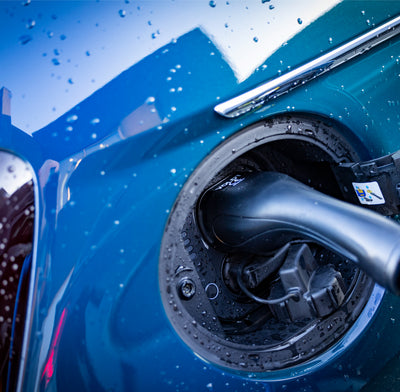
Become a partner
-
Can I charge my electric car at home without a charging station?
Yes, you can charge your electric car at home without a dedicated charging station by using a portable EV charging cable, such as the Voldt® Type 2 Granny charger. This type of cable plugs directly into a standard household socket (Schuko) and allows you to safely and reliably charge your electric vehicle. The typical charging capacity is up to 3.7 kW at 16A on 230V, which is suitable for overnight or daily top-up charging.
Using a mobile charger is particularly useful if you don’t have the option to install a fixed wallbox, such as in rental properties or temporary locations. Voldt® mobile chargers are designed with built-in safety features like temperature sensors, leakage current protection, and durable, weather-resistant materials. This ensures that even without a dedicated charging station, you're charging in a secure and compliant way.
However, it's important to note that charging via a household socket is generally slower than using a wallbox or public charging station. For example, a full charge on a 60 kWh battery could take over 16 hours. Still, for many drivers—especially those with shorter daily commutes—this is more than sufficient. If you need faster charging at home but still want flexibility, Voldt® also offers mobile charging cables for 3-phase power (up to 22 kW), provided your home installation supports it.
-
How is a commando (CEE) power outlet different from a normal outlet for extending charging cables?
A CEE (commando) power outlet is fundamentally different from a regular household socket, particularly when it comes to extending charging cables for electric vehicles (EVs). While a standard socket in most European homes supplies 230V at 10–16 amps, CEE outlets are designed to handle much higher power loads—typically 400V at 16A, 32A, or even 63A. This allows them to safely deliver the higher currents required for efficient EV charging, without the overheating risks commonly associated with standard sockets when used under continuous high loads.
CEE outlets are industrial-grade connectors, easily recognized by their round, rugged design and multiple pins—for example, separate pins for three-phase power, neutral, and earth. This configuration ensures a much more stable and secure connection, which is crucial for EV charging. Normal household sockets are not built to sustain prolonged high current draw, and using them with extension cables for EV charging can result in significant voltage drop, cable overheating, or even fire hazards. That’s why CEE connections are often recommended for heavy-duty charging scenarios, especially in outdoor or semi-permanent setups.
When extending an EV charging cable using a CEE power outlet, it's vital to use a high-quality extension lead rated for the appropriate amperage. The cable should have the correct wire gauge—typically 2.5 mm² for 16A and 6 mm² for 32A—and be heat-resistant, weatherproof, and compliant with relevant safety standards. Brands like Voldt® offer mobile EV chargers and extension cables specifically designed for use with CEE 16A or 32A outlets, supporting charging speeds up to 22 kW. This setup greatly enhances safety, efficiency, and reliability compared to using standard household sockets.
-
Can you extend mobile charging cables that you plug into a normal socket?
It is technically possible to extend mobile EV charging cables that plug into a standard household socket, but this is strongly discouraged for safety reasons. Extension cables are often not designed to handle the continuous high currents required for EV charging—typically between 10A and 16A. Using an unsuitable extension lead increases the risk of overheating, cable damage, or even fire, especially when charging over several hours. The connectors and wiring of most standard extension cords are simply not built for this kind of prolonged electrical load.
If you do choose to use an extension cable, it’s essential to use a high-quality outdoor-rated extension lead with a minimum conductor thickness of 1.5 mm²—ideally 2.5 mm²—for safe current handling. The extension cable should be properly grounded and have a high IP rating, such as IP44 or higher, to protect against moisture, dust, and other environmental hazards. A rugged, heat-resistant cable housing is also important to reduce the risk of electrical faults or insulation failure.
Still, even with the best extension cord, charging performance and safety can be compromised. That’s why Voldt® recommends selecting a mobile charger with the correct cable length from the outset. Our mobile charging cables are available in lengths up to 20 metres and are specifically engineered to handle EV charging loads safely—without relying on third-party extensions. This ensures maximum safety, full compliance with CE and TÜV certifications, and peace of mind while charging.
-
Charging an electric car with generator, is it possible?
Yes, it is possible to charge an electric car with a genset (generator), but there are important technical conditions and safety precautions to consider. First, the generator must deliver sufficient continuous power output—both in wattage and voltage stability—to match the requirements of your EV’s onboard charger. For most EVs, this means a generator with a continuous output of at least 3.5 kW for slow charging, or 7.4 kW or more for faster charging via a 32A Type 2 connection.
Secondly, it is crucial that the generator delivers clean and stable electricity, typically through an inverter generator. Poor power quality or voltage fluctuations can interfere with the EV's charging system, potentially causing charging failures or damage. Many EV chargers, including Voldt® mobile charging cables, are equipped with safety protocols that automatically stop charging if unstable power is detected, which often happens with lower-end generators.
Lastly, your charging cable must be compatible with the power characteristics of the generator. For example, a Voldt® mobile charger designed for Schuko or CEE connections must match the output plug type and phase setup of the genset. In emergency or off-grid situations, this setup can be a valuable backup, especially with a properly rated portable EV charger. However, for daily use, we strongly recommend a certified, grid-connected charging solution for optimal efficiency, safety, and convenience.
-
Can I use a three-phase EV charging cable in a single-phase charging box?
Yes, you can use a three-phase EV charging cable in a single-phase charging box, but the charging speed will be limited to the capabilities of the single-phase system. The cable will simply use one of the three phases for power transmission, while the other two remain inactive. This setup is electrically safe and commonly supported by both EVs and charging stations, provided that the connectors and standards (typically Type 2 in Europe) are compatible.
From a technical perspective, a three-phase charging cable—such as a Voldt® 22 kW Type 2 kabel—is built to handle up to 32A per phase across three phases, giving a maximum of 22 kW charging capacity. When connected to a single-phase outlet or wallbox, however, the power is limited to just one phase. This means you’ll get a maximum of 7.4 kW (32A x 230V) if the installation supports it. The cable’s internal wiring and pins will safely carry the single-phase load, as they are designed to support higher loads across more conductors.
It's also important to consider that while the cable itself is compatible, your EV and the onboard charger must also support charging over a single phase. Most European EVs do, but some older or imported models might have limitations. Additionally, the wallbox must be designed to signal correctly over a Type 2 interface and must comply with standard communication protocols (IEC 61851). If all devices in the chain are compliant and properly installed, you can use a three-phase cable in a single-phase environment without any issues.
Want to know more?
View all-

Travelling with Voldt® in the UK
EV travel tips in the United Kingdom The United Kingdom offers a large and rapidly expanding charging network, making electric vehicle travel increasingly accessible across the country. Charging availability is...
Travelling with Voldt® in the UK
EV travel tips in the United Kingdom The United Kingdom offers a large and rapidly expanding charging network, making electric vehicle travel increasingly accessible across the country. Charging availability is...
-

The Engineering Behind IP Ratings: What Makes a...
Electric vehicle charging often happens outdoors. Your cable and charger might sit in the rain, in frost, in road grit, or even in standing water. This is why weatherproofing is...
The Engineering Behind IP Ratings: What Makes a...
Electric vehicle charging often happens outdoors. Your cable and charger might sit in the rain, in frost, in road grit, or even in standing water. This is why weatherproofing is...
-

How to Reduce Degradation of Your EV’s Battery?
1. What Causes EV Battery Degradation Electric vehicle batteries degrade through two confirmed mechanisms. Calendar aging happens naturally over time as the internal chemistry of the cells changes. Cycle aging...
How to Reduce Degradation of Your EV’s Battery?
1. What Causes EV Battery Degradation Electric vehicle batteries degrade through two confirmed mechanisms. Calendar aging happens naturally over time as the internal chemistry of the cells changes. Cycle aging...
-

Type 1 vs. Type 2: What is the real difference?
What Type 1 and Type 2 connectors are Type 1 and Type 2 charging cables utilize the two most common AC charging connectors for electric vehicles in Europe. They were...
Type 1 vs. Type 2: What is the real difference?
What Type 1 and Type 2 connectors are Type 1 and Type 2 charging cables utilize the two most common AC charging connectors for electric vehicles in Europe. They were...


